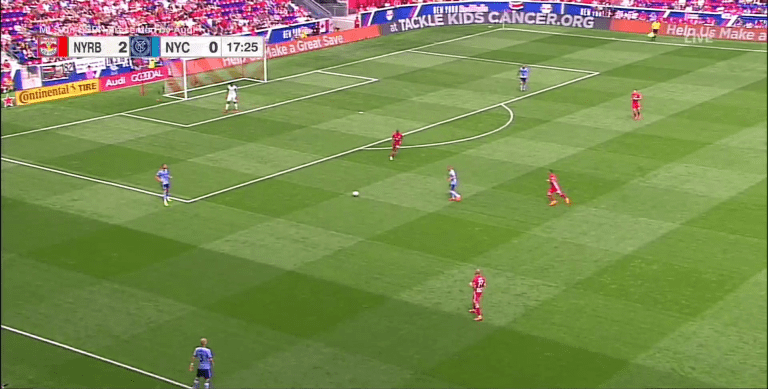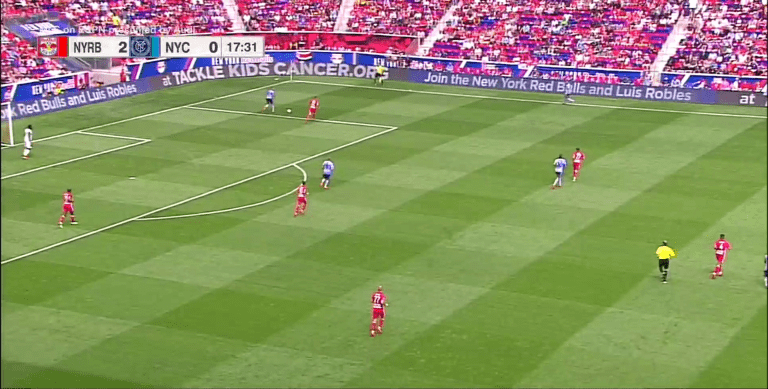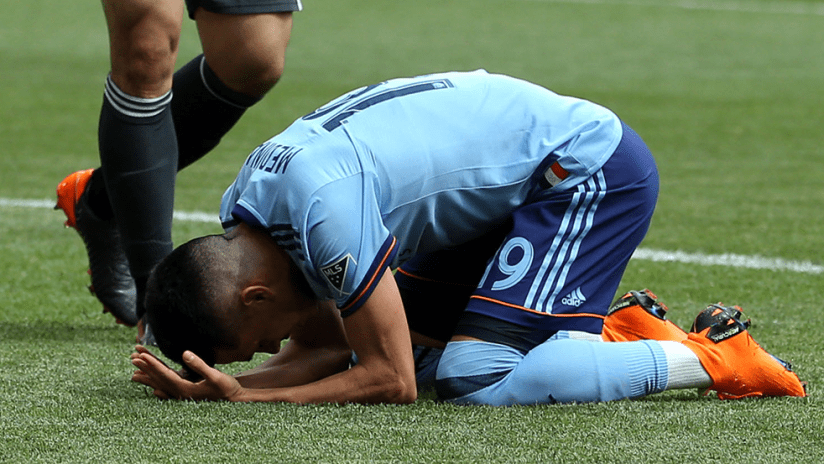The New York Red Bulls pulverized NYCFC on Saturday afternoon. They went up 2-0 inside five minutes and NYCFC never looked like they had a chance in the eventual 4-0 blowout.
After the game, NYCFC head coach Patrick Vieira didn’t hold in his frustration. He told reporters that he would have subbed all 10 field players at halftime if he could have. “If we want to keep doing well in this league,” Vieira said, “we have to change the attitude, because the attitude wasn't good tonight.”
You can’t blame Vieira for being upset, yet I’m surprised he showed it. NYCFC have been excellent so far in 2018. They are tied for third in the league in points per game. They have only dropped points in four games: away at Atlanta, away at Portland (NYCFC had 75% possession), away at New England (Possession: 70%), and away at the Red Bulls.
Those are forgivable failings. Yes, NYCFC played poorly and got crushed on Saturday, but it happens. Every team has a poor game throughout the season; you just hope you don’t get embarrassed too badly on that day. The derby was the first truly poor gave they’ve played, making it a surprise Vieira challenged his players rather than protecting them.
It’s extremely difficult for a manager to correct a lack of single-game intensity, but tactics and the general approach can always be adjusted to help the players. The first thing to note is that Red Bulls won this game; NYCFC didn’t lose it. Credit RBNY more than blame New York City. The Red Bulls played at a pace that any opponent would struggle to cope with; they executed difficult plays in critical moments; and they made minor tweaks to specifically trouble NYCFC’s approach.
Which brings us to an interesting, and yet common question: Should a team perfect a single method and trust their philosophy and execution, or regularly adapt to its opponent?
On Saturday, Vieira went with Option A. He’s been implementing a system for three years; he believes in the system and he believes in his players. Jesse Marsch is also an Option A coach. (For what it’s worth, I would be, too. I think coaches tinker too much and never allow their team to actually get good at anything.)
While the Red Bulls dominated most of the field, let's focus on the attacking third. The Red Bulls live on transition moments. One of the reasons RBNY press high up the field is to force opponents into errors and loose balls in the attacking third and middle third. If a team can get comfortable with their passing out of the back, the Red Bulls’ approach suffers. Their ability to disrupt NYCFC proved a key component of the game.
The Red Bulls did four specific things to unsettle NYCFC, beyond Red Bulls’ usual level of discomforting energy.
First, they had striker Bradley Wright-Phillips split the center backs whenever NYCFC started to build possession. In doing so, BWP kept NYCFC to one side and made the NYCFC build up more predictable. Once the game got locked to one side, Red Bulls players could step forward to press with more conviction. A lot of teams do this to NYCFC, but few do it as well as Red Bulls.

RBNY forward Bradley Wright-Phillips splitting the NYCFC center backs as they attempt to play out.
Second, the Red Bulls jumped every bumped pass. A bumped pass is one returned to the original passer. In the picture above, we see center back Maxime Chanot passing the ball to center mid Alex Ring; a bumped pass from Ring would send it directly back to Chanot on the first touch. NYCFC – and most possession teams – execute a lot of bump passes because they force the defense’s hand. The original passer can play the ball to a teammate who has a defender on his back, force the defender to close, then get the ball back and make another pass that exploits the now-vacated space. The bumped pass is a low-cost attacking move to manipulate defenders.
But the Red Bulls followed the bump. They sprinted at the original passer and everyone moved forward one layer to take the next player. RBNY pushed the initiative, allowing them to “play the game on their terms.” Time after time, NYCFC players weren’t expecting pressure and gave the ball away.
Three, Tyler Adams always stayed close to Maxi Moralez. Moralez is the player on NYCFC who takes the ball in the toughest spots. When the game gets too tight – as it often does, given NYCFC’s approach – Moralez generally pops up as if to say, “Just kick it to me as hard as you can, and I’ll get us out.” But with Adams within arm’s distance, Moralez could never find even the small space he needs. Losing Moralez as an outlet hurt NYCFC’s ability to pass.

You can see Tyler Adams and Maxi Moralez in the bottom right of the picture; Adams rarely let Moralez out of his sight in the first half.
Finally, Red Bulls pressured NYCFC goalkeeper Sean Johnson every time he got the ball. Most teams maintain their marks on field players, but let Johnson have the ball. NYCFC plays as if they know Johnson will always be a ready outlet. Johnson then has plenty of time to pick out a pass, and Johnson has gotten good at spraying diagonal passes to open up the field. He’s key to NYCFC’s game, and the Red Bulls didn’t let him be a factor. They sprinted at him every time he had the ball, forcing him into errant passes.
The combination of these tactical choices flustered NYCFC. By the 2nd half, Vieira switched his formation to a 3-5-2, moving Alex Ring to center back and Ben Sweat and Jo Inge Berget to wing backs. In adding a third player to the back line and pushing the center backs wide, NYCFC could build through slightly wider positions, ones that stretched RBNY, creating extra distance that made the Red Bulls a little later to everything. Marsch responded by going to his own 3-3-3-1 formation, followed by a 5-3-2 later in the half. Vieira might come to decide that the 3-5-2 works better in certain games.
Instead of banking on a formation switch, Vieira could consider an added passing pattern. Chanot frequently found himself with time to make a decision, and almost always passed the ball to Ring or the right back, Anton Tinnerholm – because that’s what they do every game. Those are their designated patterns; they make tight passes on one side to pull a defense over and then they are good enough players to pass out. They use the opponent’s press against them. But they couldn’t pass out Saturday, because the Red Bulls press too well.
RBNY verge on overpressing. The second you make that first pass, Red Bulls are there. You don’t need the second or third to coax them in.
Here’s a thought process Chanot could run through with the Red Bulls pushing numbers forward: If RBNY's highest players are 20 yards from the goal and midfield is 60 yards from the goal (on a standard field) and the defenders are probably at midfield, then there exist 40 yards between their players. That’s a lot. A defense can’t take away everything. There is a gap somewhere. Use it.
The ball from Chanot to David Villa that ultimately led to RBNY's first goal was actually Chanot's best pass of the game. He drove the ball over the Red Bulls' attackers and dropped it into open space. Villa messed up the touch, but it was the right pattern. Villa gave the ball away, but it was the right pass from Chanot and the one he needed to continue to go to. It’s not a “direct” or “lumped” ball; it's a skilled possession-based pass.
Once you connect that pass, you’re starting to force RBNY's hand. Red Bulls center backs would have had to step with Villa, leaving space behind them. The winger then makes a diagonal into the space. In the 12th minute, Moralez made the perfect pass:
You’ll notice he doesn’t even watch Medina make the run. He seems to understand that intense pressure must mean there's room elsewhere. Again, it’s not a “long ball” from Moralez. It’s an intentional, targeted pass, and it’s the exact thing you want when you’re a possession team: Drag a defense to a space, then hit them in the vacated areas.
NYCFC looked flat, but Vieira stands to gain from the lessons learned in this one. Scouting staffs around MLS will have watched how RBNY dismantled NYCFC, doing their usual Red Bulls things, but with a few key tactical wrinkles. Marsch made changes without changing their identity.
NYCFC remain a good team, but one whose weaknesses were exploited in prominent fashion. There's an adjustment to be made – it’s just a matter of degree.













